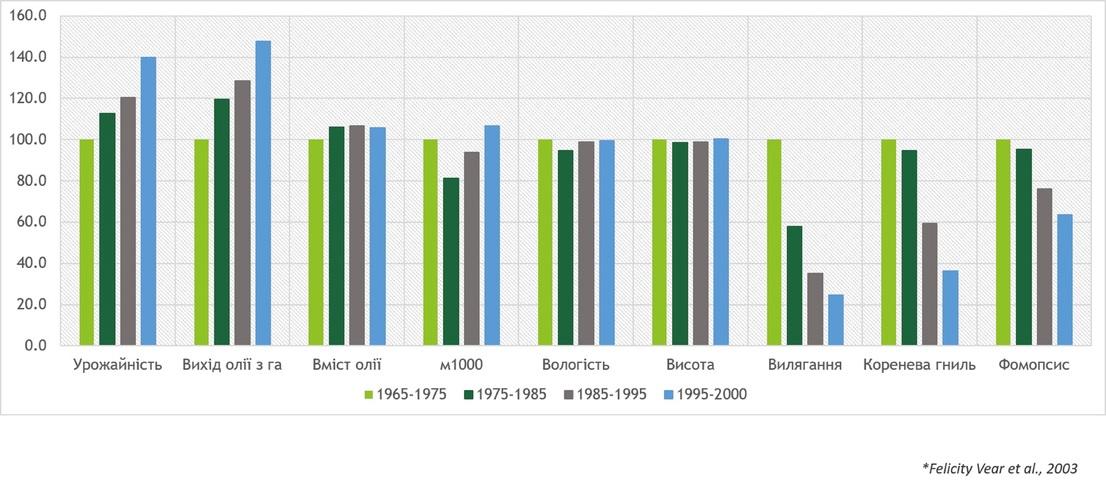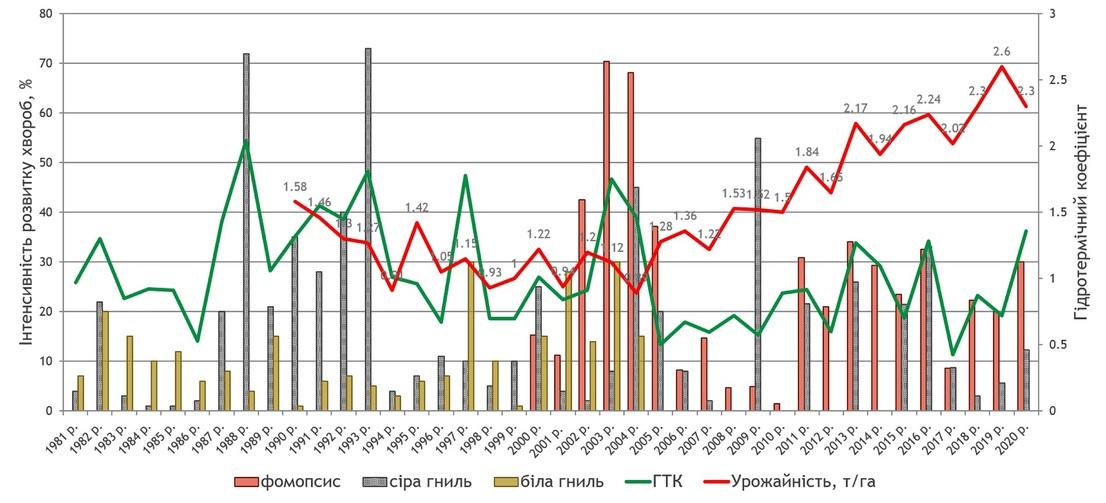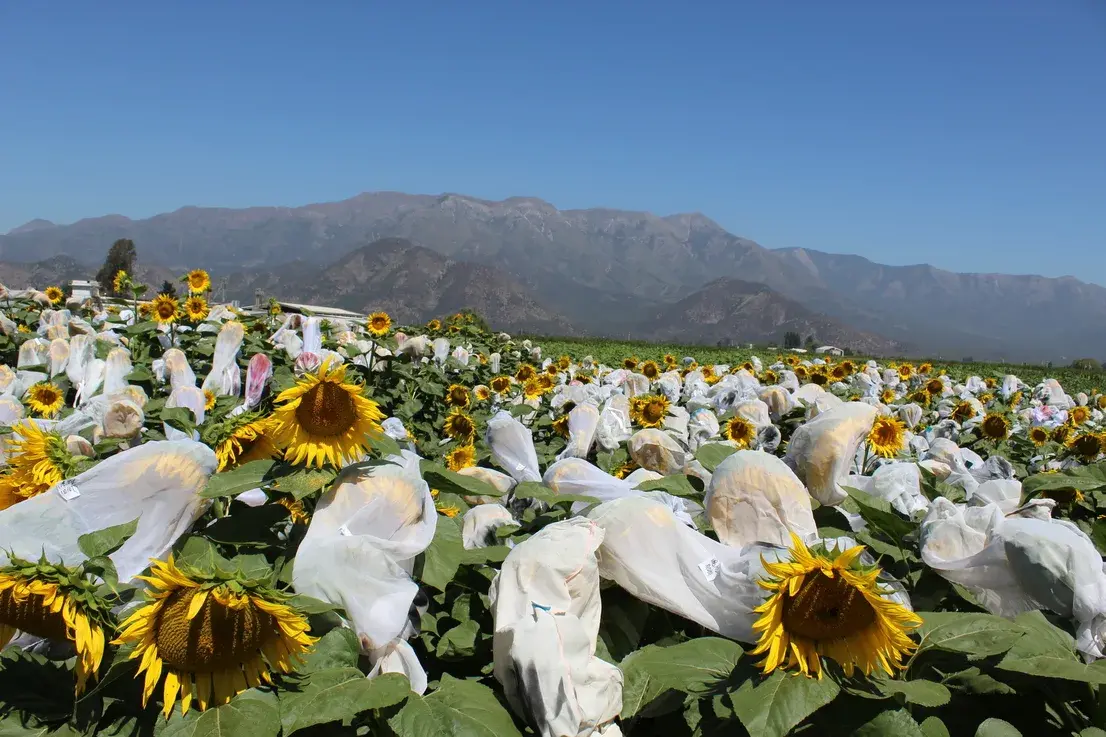New sunflower hybrids are the answer to the challenges faced by agricultural producers and a guarantee of maximum yield
Sunflower is one of the most widely grown oilseeds in Ukraine. It came to us in the 18th century and quickly gained favor due to its valuable properties. The scientific breeding of the crop began in 1912. At that time, the average yield of sunflower did not exceed 1-1.5 t/ha and did not change over the next few decades. The average yield started to increase in 2007. In 2019, it reached 2.6 t/ha, and in 2020, due to difficult weather conditions, it was at 2 t/ha.
Let's try to understand what factors affect sunflower yields and how they can be controlled.
Influencing factors
Sunflower yields have been increasing in recent years due to several factors: breeding, new crop cultivation technologies, the level of agricultural technology and agricultural machinery available to the agricultural enterprise, the nutrition system and the use of new plant protection products, as well as climate change, in particular, a decrease in the hydrothermal coefficient (HTK).
At the same time, the gap between the actual yields on farms and the potential yields that breeders say are theoretically achievable with the current level of genetic potential of hybrids is significant. How do we bridge the gap between actual and potential yields? By managing the factors I have already outlined, as well as the agronomist's understanding of how to grow the crop.
Bridging the gap between theoretical and potential yields is the task of breeding. I want to tell you how the VNIS team solves this difficult task.
Why the yields are low
Before we talk about our developments, it is worth analyzing the reasons for the gap between the potential sunflower yield and the actual yield. The crop's yield is reduced due to diseases, environmental factors such as moisture deficit and climate change. And another obstacle to maximizing yields is the use of plant protection products.
French researchers conducted an interesting experiment. They chose 20 hybrids and divided them into four groups depending on the period of their entry into the market, and studied them for such indicators as yield, oil yield per hectare, oil content in seeds, weight of 1000 seeds, humidity, height, lodging, and damage by common diseases (Fig. 1). To ensure the validity of the results of the experiment, the seeds of the hybrids were obtained in one year and sown under the same conditions in several locations with replication over the years.

Based on the analysis of the data obtained, it was found that the yield increase over the past 40 years has been 40% with approximately the same “step” of 10% each decade. The progress in oil yield over this period has reached 45%, while the oil content in seeds has remained virtually unchanged since the time of Vasyl Pustovoit, the father of scientific sunflower breeding. The selection architecture has also been preserved since the time of selection in Krasnodar. Resistance to lodging and abiotic factors has decreased fourfold, while disease resistance has increased significantly: the youngest hybrids have proven to be the most resistant to root rot and phomopsis, and the oldest are susceptible.
At present, the main areas of sunflower improvement at the Гkrainian Scientific Institute of Breeding are based on the following features: yield, nature and weight of 1000 seeds; resistance to bio- and abiotic environmental factors, oil content, oil yield per hectare; quality of fatty acid composition of oil; architectonics of new hybrids (allowing to increase sowing density), shortening of the growing season and suitability for mechanized cultivation.
Priority tasks
To solve the main task of breeding - to reduce the gap between theoretical and experimental yields - we need to pay attention to two points. The first is to increase resistance to pests, the main limiting factor for maximizing yields. The second is to determine their ecological plasticity and zoning by conducting large-scale environmental trials of new hybrids, which will help to unlock the genetic potential of yields.
Sunflower is affected by a significant number of pathogens that can cause significant damage under favorable conditions for their development, which will significantly reduce the yield. Analysis of data for the previous decades showed (Fig. 2) that in the period from 2000 to 2007 there was a dip in sunflower yields due to the strong development of diseases (phomopsis, gray and white rot, broomrape, downy mildew) caused by high precipitation and, accordingly, high GTC.

It is worth noting the increase in average sunflower yields since 2007. The next few years were drier, which limited the development of most diseases and contributed to a good sunflower harvest. Not the least of the reasons for the yield growth are the achievements in breeding, application of new agricultural technologies, and use of new plant protection products. In addition, the period of disease intensification allowed us to select more resistant genotypes, which also contributed to the increase in sunflower yields.
Our institute carries out thorough work to assess the resistance of sunflower to pathogens, which is being done by the Department of Plant Immunity to Diseases.
One of the main directions in sunflower breeding programs is to increase the resistance of new hybrids to herbicides of the imidazolinone and tribenuron methyl groups, which makes it easier to control weeds. For example, the selection of sunflower hybrids genetically resistant to imidazolinone (IMI) herbicides allows us to grow the crop in fields with the most problematic weeds (ragweed, nedreba, cyclohexa, etc.), as well as with a high level of sunflower broomrape infestation. The use of hybrids resistant to herbicides containing tribenuron-methyl (SU) allows us to treat crops with post-emergence herbicides of systemic action.
Resist broomrape
Sunflower broomrape is a very big problem in sunflower cultivation today. This floral parasite has been plaguing the crop for over 150 years. The parasite reduces the productivity of sunflower plants, preventing their normal development, which leads to significant yield losses - sometimes even up to 100%. The broomrape is especially troublesome for farmers in the South of Ukraine, and recently it has appeared in the Central part of the country (Cherkasy, Kharkiv and Poltava regions). Last year, we observed broomrape damage to crops even in the North of the country - in Zhytomyr and Chernihiv regions. Currently, broomrape is not widespread only in Khmelnytsky, Ternopil, Ivano-Frankivsk, Lviv and Volyn regions. However, if you look closely, the results may be surprising...
Over the past 10 years, under the pressure of breeding for resistance, highly virulent races have emerged, and the composition of the parasite's population differs in different areas of its distribution. That is, hybrids that are not affected in Odesa region are not immune to damage in Kharkiv region and vice versa.
The formation of new genetically different individuals with different virulence in the population occurs due to the reduced rotation of sunflower in crop rotations and the use of sunflower hybrids resistant to highly virulent races (G+) unnecessarily (the latter leads to the formation of biotypes with increased virulence, which are the basis for the emergence of a new race of broomrape in a year).
The G+ race is observed throughout Europe, overcoming the resistance of hybrids protected by the Or7 gene. Since the process of mutations in broomrape is continuous and constantly progressing, the creation of VNIS sunflower hybrids genetically resistant to new races is the main direction of breeding. Growing such hybrids, unfortunately, does not avoid the manifestation of this parasite, but it can partially reduce its amount in the fields.
Knowledge of the mechanisms of interaction between the parasite and plants is essential for developing hybrid resistance strategies. We collect broomrape seeds for research from different regions of Ukraine, as well as Turkey and Romania. We conduct field tests of breeding material for resistance in Ukraine, Spain, Turkey and Romania at 11 locations and create hybrids resistant to new races of broomrape. I would like to note that in the fight against sunflower broomrape, it is important to determine the race of broomrape in your field and not to use hybrids that are resistant to only one race.
In general, I advise you to protect yourself from the parasite in a comprehensive manner: use resistant hybrids, chemical protection, observe crop rotation and disinfect equipment when moving from one field to another. Only the integrated use of all methods can protect the spread of broomrape in your fields and slow down the formation of new races.
Our results
Today, we have almost reached the maximum sunflower yield. The main work continues to improve the existing hybrids by adding the necessary traits demanded by the market.
To ensure successful breeding, we have created a large collection of traits and genotypes, and we are constantly adding new samples. The collection contains the newest and most interesting traits that we introduce into new hybrids, such as resistance to broomrape, to several herbicides at the same time, and to pathogens. In practice, this looks like this: a hybrid that shows excellent results but does not have the required trait is backcrossed with the maternal and paternal components. In four years, with the help of accelerated breeding methods, we can get an analog of the hybrid that contains the trait we need. To speed up the breeding process, we use our biotechnology laboratories and our molecular marker laboratory; we grow hybrids in two nurseries: in summer in Ukraine, in winter in Chile, and in a greenhouse in Ukraine. This allows us to produce three generations per year. We also have joint partnership programs with domestic and foreign companies from the United States, South America, Kazakhstan, Turkey, and the European Union.
We test the resulting hybrids in Ukraine, Serbia and Romania. If the yield of the new hybrids exceeds the yield of the standards - the best foreign-bred hybrids - by 5-7% during the test, we introduce them into production. Hybrids that exceed the standards by 5-10% are left for a second stage of testing, followed by registration of the best ones in the State Register of Plant Varieties Suitable for Distribution in Ukraine.
Among our new products are the classic hybrid Lime, resistant to the G-race of broomrape; three hybrids - Amato, Folk and Shannon - resistant to tribenuron-methyl (SU) herbicides, and Amato and Folk are also resistant to the G-race of broomrape; the Euro hybrid, resistant to Euro-Lightning®; and three hybrids - Armageddon, Carlos 105 and high-oleic Everest - resistant to imidazolinone (IMI) herbicides.
Do our hybrids help to maximize yields? Absolutely! They increase your chances of getting better results. So, grow new Ukrainian sunflower hybrids and support domestic breeding.


 Choose a country
Choose a country